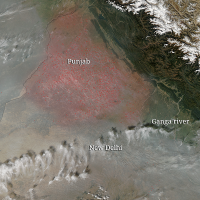Punjab Crop Fires Create Haze in Delhi
 NASA's Oct 31 photo shows the fires across farms in Punjab (represented by red dots)
NASA's Oct 31 photo shows the fires across farms in Punjab (represented by red dots)
The choking haze that envelopes Delhi every winter is not just the fallout of Diwali firecrackers or coal-based cooking fires. It is also caused in large part by the burning of crop debris by farmers in the states of Punjab and Haryana that lie north of the capital.
Every year, these farmers collectively burn between seven and eight million tons of plant debris from their rice farms. The plumes of smoke that rise from these crop fires are so significant that the National Aeronautics and Space Administration (NASA) has taken notice of the resultant pollution. The U.S. agency releases annual photos of the fires seen over millions of hectares of agricultural fields in Punjab.
“The Indian state of Punjab has two growing seasons: one from May to September and another from November to April," NASA said, according to Scroll.in. "Many Punjab farmers rotate between crops, planting rice in May and wheat in November. In order to quickly prepare their fields for the wheat crop, many farmers simply burn leftover plant debris in late-October and November after harvesting rice. The practice is known as paddy stubble burning.”
When NASA’s Moderate Resolution Imaging Spectro-radiometer’s aqua-satellite passes over Punjab, it captures the fires as well as the thick blanket of fog covering Delhi.
In NASA’s image taken on October 31, the large area covered by the red dots is where the burning was taking place. A layer of aerosols is also visible, which includes smoke, haze, dust and particulate air pollutants.
Officials of the Delhi Pollution Control Committee officials, along with scientists at System of Air Quality Weather Forecasting and Research Centre, said that such burning is adding to Delhi's local pollution load, which is expected to increase further in the coming weeks.
“Pollution doesn't have boundaries," Anumita Roy Chowdhury of the Centre for Science and Environment (CSE) told The Economic Times. "All states need to act together."
Prompted by the high air pollution in Delhi and Noida, some Noida-based environmental activists filed a petition in the National Green Tribunal last year against straw and waste burning in agricultural fields.
Crop burning is already illegal in most states in India, including Punjab, and violators are supposed to be booked under Section 188 (disobedience to order duly promulgated by public servant) of the Indian Penal Code and the Air (Prevention and Control of Pollution) Act. But as NASA’s photos show, most farmers ignore these laws and take the easy way out to clear their fields.
To Learn More:
Haze in Delhi due to agri-waste burning in Punjab and Haryana (Economic Times)
This NASA image explains why it's getting difficult to breathe in Delhi (by Sahil Bhalla, Scroll.in)
- Top Stories
- Controversies
- Where is the Money Going?
- India and the World
- Appointments and Resignations
- Unusual News
- Latest News
- India College Chain’s Expansion into U.S. Draws Opposition from Massachusetts Officials over Quality of Education
- Milk Shortages in India Tied to Release of New Movies Featuring Nation’s Favorite Stars
- Confusion Swirls around Kashmir Newspaper Ban in Wake of Violent Street Protests
- Polio-Free for 5 Years, India Launches Vaccine Drive after Polio Strain Discovery
- New Aviation Policy Could Increase Service, Lower Ticket Prices






Comments